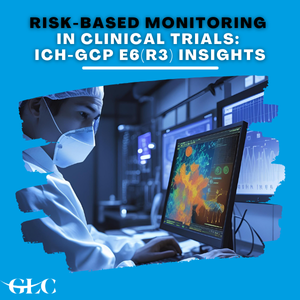Free knowledge to monitor the world of events. Have a look at our must read Blogs on Pharma, Finance, HR, Health and Cross Industry.
Risk-Based Monitoring in Clinical Trials: ICH-GCP E6(R3) Insights
2022-08-16
The traditional monitoring approachesmarked by frequent site visits and a high degree of source data verificationare giving rise to dynamic, efficient methods.
As the evolving situation in clinical studies advances at a rate faster than ever before, data integrity and participant safety have always remained paramount. The traditional monitoring approachesmarked by frequent site visits and a high degree of source data verificationare giving rise to dynamic, efficient methods. At the forefront of this revolution is Risk-Based Monitoring (RBM), an approach that targets resources at high-risk areas. With the introduction of ICH-GCP E6(R3), RBM has received a huge boost, revolutionizing clinical trials and their monitoring globally.

What is Risk-Based Monitoring (RBM)?
Risk-Based Monitoring is a strategic monitoring plan for clinical trials that focuses on the most important risks to trial quality and patient safety. Rather than laying down a single level of monitoring across all aspects of a trial, RBM allows sponsors and CROs to utilize resources most effectively by identifying and addressing the risks that are most likely to impact the trial.
Key features of RBM are:
- Centralized Monitoring: Utilizing statistical and analytical software to review data trends remotely and identify anomalies.
- Reduced Source Data Verification (SDV): Isolating verification efforts to important data points.
- Targeted On-Site Monitoring: Site monitoring triggered by data-enabled prompts rather than pre-planned schedules.
- Risk Assessment and Categorization: Evaluating and categorizing trial risk when the study commences and at regular intervals throughout the trial life cycle.
ICH-GCP E6(R3): A Game-Changer for RBM
The ICH Good Clinical Practice (GCP) E6(R3) guideline, released as a revision to E6(R2), is concerned with an efficient, proportionate-to-risk method of running and monitoring trials and emphasizes RBM as best practice.
The following is how E6(R3) impacts and encourages Risk-Based Monitoring:
- Risk-Proportionate Approach to Quality Management
E6(R3) puts Quality by Design (QbD) first in clinical trials, with sponsors encouraged to define critical-to-quality (CTQ) factors from the beginning. Early identification makes it easy to develop RBM plans with a focus on high-priority elements, achieving better efficiency and effectiveness.
- Technology and Data Analytics Integration
E6(R3) emphatically recognizes the role of modern technologies towards enhanced supervision. Centralized watching and information analysis are not only encouraged but actively fostered, allowing for improved identification of issues without redundant site visits.
- Continuous Risk Assessment
Unlike previous incarnations, E6(R3) promotes continuous evaluation of risk throughout the trial process. Continuous evaluation complements hand-in-glove RBM, reliant on dynamic re-evaluation of risk for monitoring activity recommendations.
- Responsibility and Supervision
E6(R3) places formal roles and duties on sponsors, CROs, and investigators in the context of risk management. It requires documentation and justification for the monitoring approach utilized, thereby incorporating RBM practices into systems of compliance.
Benefits of RBM Under E6(R3)
- Improved Resource Allocation: Focused efforts where needed most, resulting in cost reduction and process optimization.
- Improved Patient Safety: Early detection can prevent harm and improve the participants' experience.
- Validity of Data: Central monitoring instruments make it possible for trends, anomalies, or fraud to be identified more effectively than traditional methods.
- Regulatory Compliance: With E6(R3) facilitating RBM, sponsors can have confidence that their process is according to international standards.
Challenges and Considerations
Though RBM under E6(R3) has numerous advantages, implementation is not easy:
- Cultural Change: Mind-set changes in organizational thinking are essential to transition from traditional monitoring processes to risk-based processes.
- Training: RBM tools, processes, and regulatory expectations must be trained to by the teams.
- Technology Dependence: Reliable data collection and analysis platforms must be installed to ensure smooth RBM, which may involve some initial investment.
Conclusion
The release of ICH-GCP E6(R3) is a tipping point in clinical trial conduct. By codifying and formalizing Risk-Based Monitoring, E6(R3) forces sponsors and CROs away from rigid, one-size-fits-all monitoring strategies. Clinical trial monitoring in the future is mobile, data-focused, and risk-based, and leads to safer studies, better data, and more efficient research findings
To those firms embracing it, the capacity for innovation and improved clinical trial performance is deep.
Do you want to understand more? Join our upcoming Risk Based Monitoring and the impact of ICH-GCP E6 R3 Masterclass.
By Shara Najimudeen, Digital Marketing Executive, GLC Europe, Colombo Office, Sri Lanka.
Get a feel for our events

Training Program for CMC Leaders - EU edition
27th October 2025 - 16th January 2026
Rich with practical insights and real-world applications
learn more >>
Training Program for CMC Leaders - US edition
27th October 2025 - 16th January 2026
Rich with practical insights and real-world applications
learn more >>
Mastering the Common Technical Document (CTD) for Biologics Masterclass - EU edition
12-16 January, 2026
From guidelines to submissions
learn more >>














